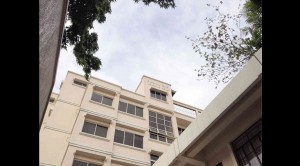Priests age with grace in ‘House of Sin’
Father Arsenio Nalunat, 70, has a room of his own in the five-story Cardinal Sin Welcome Home (CSWH) within the compound of Our Lady of Loreto Parish Church in Sampaloc, Manila.
Though aided by a wheeled walker as a private nurse stood behind him, Nalunat barely showed signs of the stroke he suffered in 2008 and which left him comatose—and “just dreaming”—for seven months.
“But one-fourth of my skull is gone,” said Nalunat, smiling and proud of having survived the surgery he had to undergo while in a coma.
His body may be frail but the self-deprecating humor remained undiminished. “Eto, ‘retireded,’” he said, when asked how he was feeling that day; he meant both “retired” and “retarded.”
Nalunat is one of the eight aging priests currently staying at the CSWH, a place for retirement run by the Catholic Church for clergymen who either have no more family members to take them in or have decided stay close to their spiritual brothers in their senior years.
Article continues after this advertisementWith a mere five-member staff, the CSWH building has 40 rooms, two elevators, a chapel and a gym. Built in 2002 during the time of the Manila Archbishop Jaime Cardinal Sin, it provides round-the-clock nursing care, maintenance medicines and the comforting atmosphere befitting the graying apostles of the faith.
Article continues after this advertisementCBCP’s appeal
Earlier this year, the likes of Nalunat became the subject of an appeal from the Catholic Bishops Conference of the Philippines (CBCP), which called on the laity to pray for and help finance the care of old and ailing priests in their dioceses.
Msgr. Sabino Vengco, founding chair of the Kadiwa sa Pagkapari Foundation Inc., an organization looking after such priests, said the retirees under the care of the Archdiocese of Manila are far more fortunate compared to those based in the provinces.
In Nalunat’s case, he has relatives who occasionally visit him in Sampaloc. He said he had opted to stay at the retirement home since all of them have their own families or businesses to attend to.
Nalunat had served as parish priest in Malampaya, Palawan province; San Roque Cathedral in Caloocan City, and San Pancracio Parish inside La Loma cemetery in Quezon City.
Vengco noted that priests, like everybody else, inevitably slow down, “but what is striking is that the priests don’t always have their family to take care of them.”
Their situation varies according to their economic status or the conditions in their last diocese.
Those who come from well-to-do families can afford to hire a nurse or caregiver 24/7. “Others who come from average families can avail themselves of the retirement home of the archdiocese but cannot afford what their wealthier counterparts enjoy,” he said.
In Metro Manila, retired priests get a monthly pension of P20,000 which, according to Vengco, is often not enough for those requiring expensive medical treatment or procedures, such as dialysis.
P1,500 monthly pension
“But go to Leyte and Samar provinces and you’d find priests living on P1,500 monthly pension,” he said. In Palo, Leyte, for example, aging priests rely on private donations for the maintenance of their retirement home. Other towns are simply too poor to extend such assistance.
Through the years, Kadiwa has been appealing to lay people—“pricking their conscience”—for them to send help to these priests, not just in Metro Manila.
“These elderly folk are precious,” the monsignor stressed. “In any culture, the way you treat your elderly reveals the kind of civilization you have—or whether you have none.”
Taking good care of old priests would also raise the morale of the younger people who have the desire to join the priesthood, he said.
According to data from Kadiwa, for every 5,000 clergymen across the country, 300 are retirees. The retirement age for Catholic priests is 75, but those suffering from serious health problems may apply for retirement at an earlier age.
At the CSWH, Kadiwa sees to it that the retirees are kept “busy” through various activities. They are also brought to Tagaytay City for an annual retreat, while members of their past congregations are encouraged to pay them a visit.
“Our old priests get depressed, too,” Vengco said. “Most of them feel that sense of isolation, after spending many years at center stage managing the affairs of the Church. Now they are marginalized, which is not an easy thing to accept.”
Nalunat, however, doesn’t consider himself left out or set aside, even though his daily morning routine is usually nothing more than a slow walk to the chapel, where he can spend unhurried time in prayer and reflection. The trip alone “still makes me happy.”
“With God, I’m never alone.”
